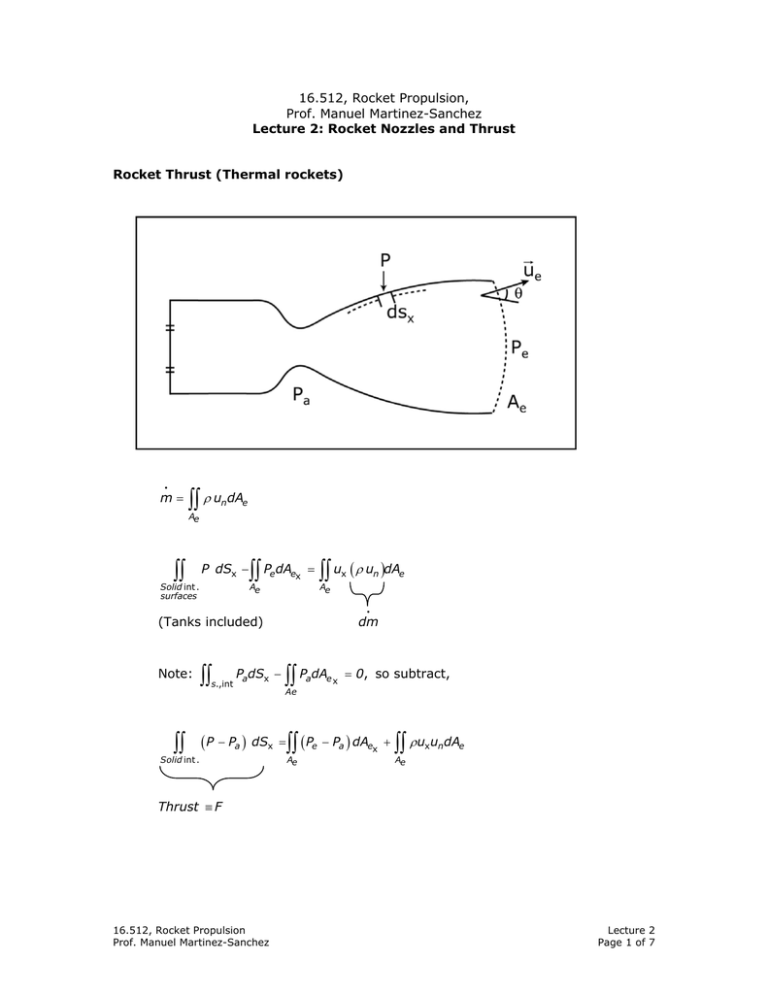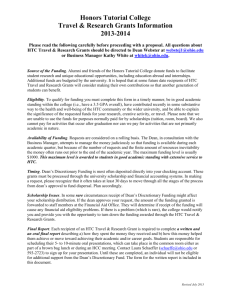∫∫ ( )
advertisement

16.512, Rocket Propulsion, Prof. Manuel Martinez-Sanchez Lecture 2: Rocket Nozzles and Thrust Rocket Thrust (Thermal rockets) i m= ∫∫ ρ u dA n e Ae ∫∫ P dSx − Solid int . surfaces ∫∫ P dA e ex = Ae ∫∫ u x i dm (Tanks included) Note: ∫∫ ∫∫ s.,int PadSx − ( P − Pa ) ( ρ un )dAe Ae ∫∫ P dA a ex = 0, so subtract, Ae dSx = Solid int . ∫∫ ( P e Ae − Pa ) dAex + ∫∫ ρu u dA x n e Ae Thrust ≡ F 16.512, Rocket Propulsion Prof. Manuel Martinez-Sanchez Lecture 2 Page 1 of 7 ∫∫ ρu u dA x n In general then, define ue = e Ae ∫∫ ρu n dAe Ae ∫∫ P dA e and P e = ⇒ ex Ae Aex i ( ) F = m u e + P e − Pa Aex If things are nearly constant on spherical caps, modify control volume to spherical wedge: i m= ∫∫ ρu dA r Ae ∫∫ ( P − Pa ) dSx − int . solids. dAex = dA cos θ 16.512, Rocket Propulsion Prof. Manuel Martinez-Sanchez ∫∫ ( P e − Pa ) dAex = Ae ∫∫ ( ρu ) u dA r x Ae ux = ur cos θ Lecture 2 Page 2 of 7 Define ue = ∫∫ Ae ρ ur ux dA i m ∫∫ Ae ; Pe = Pe dAex Aex and use dA = 2π r sin θ rdθ For ideal conical flow, ρ , ur , P are constant over Ae . Then ue = ρ ur2 ∫∫ ρ ur Ae cos θ dA ∫∫ Ae dA = ur ∫ α 0 2π r sin θ cos θ dθ ∫ α 0 2π r sin θ dθ 1 sin2 α = ur 2 1 − cos α or ue = ur 1 + cos α 2 Also, since Pe = const on the exit surface, 16.512, Rocket Propulsion Prof. Manuel Martinez-Sanchez P e = Pe Lecture 2 Page 3 of 7 ∫ ( P − P )dA a x + s.s. ∫ (P e − Pa )dAx = Ae ∫ ( ρu dA)u n x Ae F ( i ) F = m u e + P e − Pa Aex i m= ue = ∫ ρundA Ae ∫ ∫ Ae ρ unux dA Ae Pe ∫ = ∫ Ae Pe dAx Ae Ax = ∫ Ae ρ un dA dAx dAx At design, Pe = Pa (and parallel flow beyond). Also ue x i Then uniform → F = m uex 16.512, Rocket Propulsion Prof. Manuel Martinez-Sanchez Lecture 2 Page 4 of 7 Energy Considerations So, momentum balance gives the Thrust Equation. What does an Energy Balance give? Start with a near-stagnant flow in the upstream plenum (“combustion chamber”, or “nuclear heater” or “arc heated plenum”). The total specific enthalpy 1 htc = hc + υc2 ≅ hc may be different for different streamlines, due to combustion 2 “streaks:, arc constriction, etc., But along the flow expansion in the nozzle, ht is conserved for each streamline. At the exit, he + 1 2 υe = hto 2 (each streamtube) ( ) υe = 2 htc − he ≅ 2 ( hc − he ) or For a well-expanded nozzle, with large area ratio, he → o by adiabatic expansion, and υe tend to a max. υe MAX = 2 h tc . In any real, finite expansion, he ≠ o, so some of htc is wasted as thermal energy in the exhaust. Define a nozzle efficiency. ηN = htc − he htc ⎛P h T For ideal gas, e = e = ⎜⎜ e hc Tc ⎝ Pc =1− ⎞ ⎟⎟ ⎠ γ −1 γ he h ≅1− e htc hc . But, in any case, υe = υe MAX ηN = ηN 2 htc Since Pe ≅ uniform, so is ηN , even when (i.e., ηN = υe2 2 htc ) htc is not. Also, υe is non-uniform if htc is htc ). (in proportion to The Jet Power is the kinetic energy flow out of the nozzle PJet = ( ) 1 m htc − he = ηN htc m 2 16.512, Rocket Propulsion Prof. Manuel Martinez-Sanchez Lecture 2 Page 5 of 7 Effect of Stagnation Enthalpy Non-uniformities Consider a case where htc varies from streamtube ( dm ) to streamtube (but Pe=const., so ηN = const.). Then F = ∫∫ υ e dm + ( Pe − Pa ) Ae For Pa = o (vacuum operation) and PaAe << F (large expansion), (or if Pe = Pa) F ≅ ∫∫ υ e dm = 2 ηN and the input power is P = ∫∫ h ∫∫ htc dm (1) dm tc (2) ⎧⎪P is minimum(For a given F, m)⎫⎪ It can be shown that ⎨ ⎬ if the flow is uniform ⎩⎪or F is maximum ( given P, m) ⎭⎪ ( htc =const.). If it were, we would have FUNIF . = 2 ηN m htc ; PUNIF = m htc 2 Eliminating htc , PUNIF ⎛ F ⎞ F2 F2 = m ⎜ UNIF ⎟ = UNIF = ⎜ 2η m ⎟ 2 ηN m 2 ηN m N ⎝ ⎠ Define an “efficiency” ηUNIF = PUNIF (for a given thrust) PACTUAL Now, express in general F by (1) and P by (2) ηUNIF = ( 2 ηN 2 ηN ∫∫ htc dm ( ∫∫ dm)( ∫∫ h tc Define “generalized vectors” u = 1 Then ηUNIF = (u 2 u i υ) 2 i υ 2 ≤1 16.512, Rocket Propulsion Prof. Manuel Martinez-Sanchez ( = cos 2 ) 2 dm ) υ = htc in the space of the dm values. ) θu iυ . Lecture 2 Page 6 of 7 Equality applies only when υ is a constant, i.e., htc =const. This proves the “ansatz”. 50% of flow has htc = 0.5 htc 50% of flow has htc = 1.5 htc Example: 2 ηUNIF 1 ⎛1 ⎞ ⎜ 2 0.5 + 2 1.5 ⎟ ⎠ = 0.933 (6.7% energy loss due to nonunif. = ⎝ 1 ⎛1 (1) ⎜ 2 0.5 + 2 1.5 ⎞⎟ ⎝ ⎠ Important in arcjets, less in film-cooled chemical rockets. 16.512, Rocket Propulsion Prof. Manuel Martinez-Sanchez Lecture 2 Page 7 of 7



